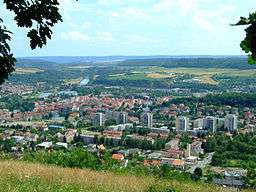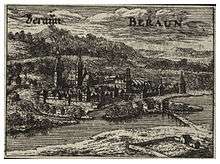Beroun
| Beroun | |||
| Town | |||
 View of Beroun | |||
|
|||
| Country | Czech Republic | ||
|---|---|---|---|
| Region | Central Bohemian | ||
| District | Beroun | ||
| Commune | Beroun | ||
| River | Berounka | ||
| Elevation | 235 m (771 ft) | ||
| Coordinates | CZ 49°57′51″N 14°4′26″E / 49.96417°N 14.07389°ECoordinates: CZ 49°57′51″N 14°4′26″E / 49.96417°N 14.07389°E | ||
| Area | 31.31 km2 (12.09 sq mi) | ||
| Population | 19,145 (01/2015) | ||
| Density | 611/km2 (1,582/sq mi) | ||
| First mentioned | 1265 | ||
| Mayor | Ivan Kůs | ||
| Timezone | CET (UTC+1) | ||
| - summer (DST) | CEST (UTC+2) | ||
| Postal code | 266 01 | ||
  Location in the Czech Republic
| |||
| Wikimedia Commons: Beroun | |||
| Statistics: statnisprava.cz | |||
| Website: www.mesto-beroun.cz | |||
Beroun (Czech pronunciation: [ˈbɛrou̯n]; German: Beraun) is a town in the Central Bohemian Region of the Czech Republic. It is the administrative centre of Beroun District.
Geography
It is located about 30 kilometres (19 mi) southwest of Prague at the confluence of Berounka and Litavka rivers. The town is part of the Prague metropolitan area. As of 2011, it has a population of 18,930.
Beroun lies on the D5 motorway, which connects Prague with Plzeň and, farther afield, with the German border and the Bundesautobahn 6 to Nuremberg, part of the European route E50.
History
A settlement na Brodě ("by the ford") was first mentioned in a 1088 deed. As a royal Bohemian town, it received its present name in the 13th century, derived form of (Welsch-)Bern, the archaic German name of Verona in Italy. Already in the High Middle Ages under the rule of King Wenceslaus II, it was a fortified town. Many citizens were German merchants, settling here in the course of the Ostsiedlung.
Beroun officially obtained town privileges from the hands of Emperor Charles IV, who was specially attached to the place, calling it "Verona mea." Under his patronage the town rapidly prospered.[1] In 1421 Hussite forces under the command of Jan Žižka stormed the town, and though it was retaken and devastated after the Battle of Lipany, it has remained a mainly Czech settled town since then.

Under the rule of the House of Habsburg from 1526, the town's estates were seized. During the Thirty Years' War it was sacked by the Imperial army, the Saxon and the Swedish forces in turn. In the First Silesian War the same fate befell it at the hands of the French and Bavarian troops.[1]
A garrison town since the 18th century, Beroun did not prosper again until in the 1860s with the opening of limestone quarries and iron ore mines. Beside several ironworks, Beroun became the site of textile manufacturing and the population increased.
Twin towns
Beroun is twinned with the following towns:
Notable People
- Otokar Feistmantel (1848–1891), geologist and paleontologist
- Václav Talich (1883–1961), conductor, died in Beroun
- Monica Sweetheart, born 1981, actress.
See also
References
- 1 2
 One or more of the preceding sentences incorporates text from a publication now in the public domain: Chisholm, Hugh, ed. (1911). "Beraun". Encyclopædia Britannica. 3 (11th ed.). Cambridge University Press. p. 764.
One or more of the preceding sentences incorporates text from a publication now in the public domain: Chisholm, Hugh, ed. (1911). "Beraun". Encyclopædia Britannica. 3 (11th ed.). Cambridge University Press. p. 764.
External links
| Wikimedia Commons has media related to Beroun. |

